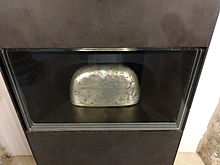Hildesheim Marian reliquary
The Hildesheim Marian Reliquary ( Shrine of Our Lady ; Lipsanothek ) is a Carolingian reliquary from the Hildesheim Cathedral Treasury .
history
Tradition and legend see in it that reliquary that Emperor Ludwig the Pious and his companion once forgot in the forest or could not remove from a rose bush and thus brought about the foundation of the Hildesheim Mariendom and the diocese of Hildesheim in 815. To this day it embodies the historical identity and continuity of the diocese. When a new Bishop of Hildesheim is consecrated or enthroned , it is ceremoniously presented to him by the predecessor or the diocesan administrator as a special sign of taking possession of the diocese .
description
The silver reliquary capsule is the oldest part of the work of art. It can be removed from the golden frame and was probably worn around the neck of the bishop during processions or dangerous undertakings (such as the Battle of Dinklar ) in the Middle Ages . The peculiar semicircular, downwardly open shape of the capsule is unprecedented. The surface is covered symmetrically with engraved and deeply gilded tendrils of a tree of life . There are parallels for these ornaments from the early 9th century. The capsule should therefore actually have been made in the Carolingian court workshop at this early stage . It is already mentioned in the cathedral's oldest treasure registers. With the holy contents and the precious capsule, Ludwig the Pious would have endowed the Marian diocese he founded and entrusted the protection of the Mother of God .
It is not known which relics the vessel contains. Probably the lost original bottom plate of the capsule provided information about this. A reliquary index of the cathedral from the time around 1200 names as contents: In capsa argentea continentur reliquie sancte Dei genitricis Marie: de crinibus, de unguibus, de lacte et de vestimentis, de sudario Domini, de sanguine Domini, de circumcisione Domini (“In one The silver capsule contains the relics of the Holy Mother of God: of the hair, of the fingernails, of the milk and of the clothes, of the handkerchief of the Lord, of the blood of the Lord, of the circumcision (foreskin) of the Lord ”). Today an inscription runs over the crest of the capsule, which is continued on the base plate from the 14th century: [C] OR [PO] RA S (an) C (t) ORV [M IN PACE] SEPULT [A] SV [ NT] ("The bodies of the saints are buried in peace", according to Sir 44.14 EU ). This word from the liturgy of the saints does not fit well with Mary, whose body, according to the Catholic faith, was not buried but taken up into heaven and by whom only relics of touch are venerated. Also, an original inscription would not simply subsume Mary under “the saints”. Paleographic peculiarities corroborate the assumption that the inscription was only attached at the same time as the new base plate and that this previously belonged to a different reliquary.
Younger than the silver capsule are the gold band setting set with gemstones and the base of the reliquary. Like the bottom plate of the capsule, this dates from the end of the 14th century, while the one from the second decade of the 13th century.
Today's retention
In the course of the cathedral renovation 2010-2014, a stele was set up in the apse apse of the cathedral crypt , which carries a venerated image of the enthroned Mother of God. The Marian reliquary - without the Gothic foot - was placed in the shaft of the stele. This means that it is in the immediate vicinity of the roots of the millennial rose bush that grows on the outside of the apse. A copy of the Marian reliquary is in the cathedral museum.
literature
- Michael Brandt: Sanctuary of Our Lady , in Bernward von Hildesheim and the age of the Ottonians , Vol. 2, Zabern, Mainz 1993, ISBN 3-8053-1567-8 , pp. 445–448.
Web links
Individual evidence
- ↑ Brandt p. 447.
- ↑ inschriften.net , note 21
- ↑ Anders Brandt p. 447, who reports the palaeographic findings, but would like to consider the part of the inscription on the capsule to be original without discussing the content.


